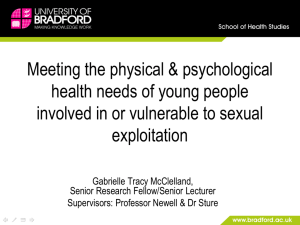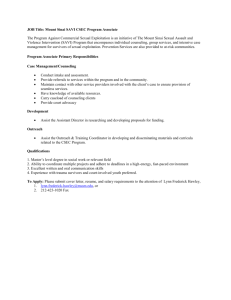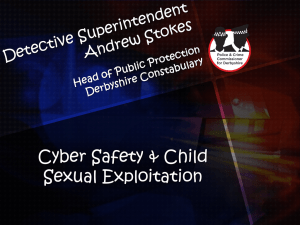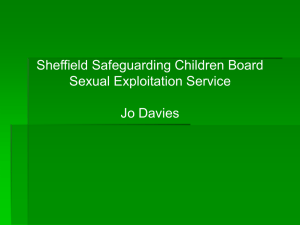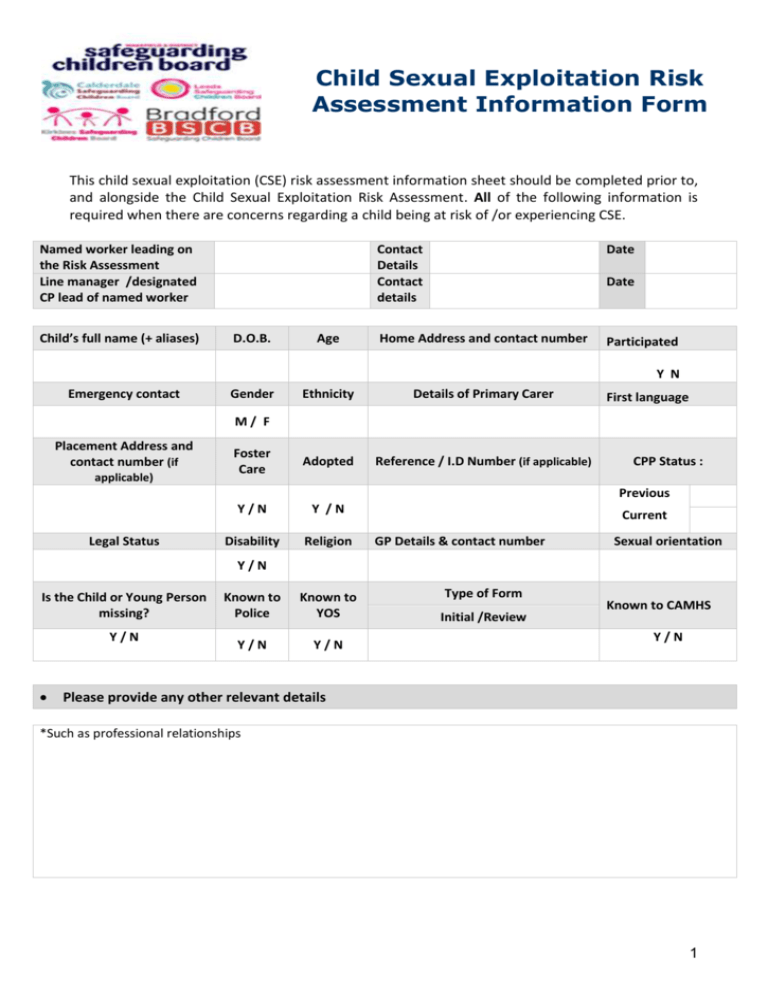
Child Sexual Exploitation Risk
Assessment Information Form
This child sexual exploitation (CSE) risk assessment information sheet should be completed prior to,
and alongside the Child Sexual Exploitation Risk Assessment. All of the following information is
required when there are concerns regarding a child being at risk of /or experiencing CSE.
Named worker leading on
the Risk Assessment
Line manager /designated
CP lead of named worker
Child’s full name (+ aliases)
D.O.B.
Age
Contact
Details
Contact
details
Date
Home Address and contact number
Participated
Date
Y N
Emergency contact
Gender
Ethnicity
Details of Primary Carer
Foster
Care
Adopted
Reference / I.D Number (if applicable)
Y/N
Y /N
Disability
Religion
First language
M/ F
Placement Address and
contact number (if
applicable)
CPP Status :
Previous
Legal Status
Current
GP Details & contact number
Sexual orientation
Y/N
Is the Child or Young Person
missing?
Y/N
Known to
Police
Known to
YOS
Y/N
Y/N
Type of Form
Initial /Review
Known to CAMHS
Y/N
Please provide any other relevant details
*Such as professional relationships
1
Child Sexual Exploitation Risk Assessment
The West Yorkshire Child Sexual Exploitation Risk Assessment should be developed
alongside with and complimenting any other plan for the young person’s welfare.
Please use this tool in line with local LSCB Procedures
Professional Assessment of CSE Risk Indicators
In order to identify children at risk of sexual exploitation or experiencing sexual exploitation and
follow a clear plan of effective inter-agency action, consider ALL of the 14 risk indicators and
record a level of risk against each, before proceeding according to local procedures.
Note: where a child under the age of 13 years old, and /or has learning disability and there are
concerns regarding sexual exploitation, a referral to Children’s Social Care is required.
The 14 main heading risk indicators are not exhaustive; they are simply those mostly commonly
recognised which may indicate a risk of sexual exploitation; there may be other relevant factors
present which require consideration and analysis. One tick in a high risk box, or several in low
risk may indicate a serious risk of sexual exploitation, alternatively this might be an indication of
other concerns that require addressing via the child’s overall plan, or by accessing other
appropriate services
The risk and vulnerability factors provided against each of the 14 risk indicator headings are also
not exhaustive; they are simply prompts for consideration. Consequently, the recorded risk for
each of the 14 risk indicators does not necessarily need to correspond with the risk and
vulnerability factors highlighted. It is therefore important to provide analysis to evidence how
the assessment of an individual risk indicator has been achieved.
When assessing a child or young person’s risk of CSE, it is essential to highlight if the concerns
and the information being provided is current or historic. If the concern or information is
historic but relevant, it necessary to evidence how this relates to the current assessed risk.
When completing the CSE risk assessment, it is crucial that the child or young person’s use of
social media is considered throughout.
*Please indicate a level of assesses risk against ALL the following 14 risk indicators
Formatted August 2015
(1)
No risk
identified
Low
Family and peer
relationships
Medium
High
Risk Indicator
No concerns identified in this area which relate to sexual
exploitation.
Carer(s) show warmth, support the child and have positive
communication with the child
Appropriate boundaries are in place and effective.
The child /young person has positive friendships
But reported reduced contact with family /friends which is of
concern and /or there is an unexplained change in attitude from
the child /young regarding the relationship, which raises some
concerns.
Carer(s) lack understanding, tolerance and warmth towards the
child. Parents fail to report missing episodes
Family relationships are strained.
Friends /carers report a change in behaviour /reduced contact
Appropriate boundaries are not always adhered to
Family /Friends /peers are known offenders.
Suspected abuse in family (emotional, neglect, physical or sexual)
There is little or no communication between the carer(s).
There is a lack of warmth/understanding/attachment and /or trust.
Parents fail to report missing episodes / Parent/Carer does not
implement age appropriate boundaries
Breakdown in family relationships / no contact.
Family /Friends /peers are known offenders.
Child /young person is socially isolated from peers
Friends are assessed to be at risk of CSE
Analysis
(2)
No risk
identified
Low
Accommodation
Medium
High
Analysis
Formatted August 2015
Risk Indicator
No concerns identified in this area which relate to sexual
exploitation
Some accommodation issues / concerns, but overall
accommodation meets the child /young person’s needs and the
child is happy
Unsuitable/ unstable / temporary/overcrowded/hostel /refuge/
unsupported. The child /young person is unhappy with their
accommodation and this impacts on their risk of CSE.
Lives in a gang neighbourhood
Unsuitable /unstable / temporary/ overcrowded/hostel
/refuge/unsupported. Concerns about location and isolation
The child /young person is unhappy with their accommodation and
often stays elsewhere.
Homeless or Sofa surfing
Care leaver or Looked After Child
(3)
Education
No risk
Identified
Low
Medium
High
Risk Indicator
No concerns identified in this area which relate to sexual
exploitation
Mainly engaged in employment / school /training
Some truanting but limited concerns, mainly positive friendships in
education /training or employment setting.
Full time education /training or employment but irregular /poor
attendance / whereabouts during school hours often unknown.
Attendance at PRU /poor attendance
Regular breakdown of school /training placements due to
behavioural problems.
Friendships in education /training or employment setting are with
others at risk of CSE
Noticeable change in attendance, performance or behaviour
Regular breakdown of school /training placements due to
behavioural problems. Not engaged in education/employment or
motivated to be. Excluded.
Whereabouts often unknown.
Friendships /peer groups either within or outside the education/
employment /training setting are with others at risk of CSE
Analysis
(4)
Emotional
Health
No risk
identified
Low
Medium
High
Analysis
Formatted August 2015
Risk Indicator
No concerns identified in this area which may relate to sexual
exploitation
Concerns regarding fatigue, poor self-image, expressions of
despair, low mood, Self-harm, Cutting, Overdosing, Eating disorder.
Some sexualised risk taking
Low self-esteem / self-confidence, expression of despair. Internal
Self-harm: Cutting, Overdosing, Eating disorder
Sexualised risk taking
External (intensive acting out): Bullying / threatening behaviour,
aggression, violent outbursts, Offending behaviour, sexualised risk
taking. Concerning substance misuse
Chronic low self-esteem / self confidence
Mental health problems, expression of despair
Internal (Self-harm): Cutting , Overdosing, Eating disorder
Previous suicide attempts, sexualised risk taking
External (intensive acting out):, Bullying / threatening behaviour,
Violent outbursts, Offending behaviour, Repeated sexualised risk
taking. Dependency on substances /alcohol.
(5)
Experience of
Violence
No risk
identified
Low
Medium
High
Risk Indicator
No concerns identified in this area which relate to sexual
exploitation.
No known reported incidents of the child /young person being a
victim of violence or witnessing domestic abuse, (including peer
relationships) although some professional concerns.
Concerns that the child /young person has been /is being exposed
to violence in the home and /or from others. Abusive significant
relationship
Physical symptoms suggestive of physical /sexual assault.
Disclosure of physical / sexual assault followed by withdrawal of
allegation.
Living in a gang neighbourhood
Known abuse towards the child /young person from family
members
Peers /older friends/partners are violent towards the child /young
person. Abusive significant relationship
Physical injuries – external / internal / disclosure of physical /
sexual assault.
Evidence of coercion /control
Analysis
(6)
Running away /
going missing
No risk
identified
Low
Medium
High
Analysis
Formatted August 2015
Risk Indicator
No concerns identified in this area which relate to sexual
exploitation. Concerns relate to behaviours which fall within
normal child /young person behaviour.
Often comes home late / Incidents of absence without permission
and returning late. Whereabouts often unknown.
Often staying out late or overnight without permission
/explanation. Whereabouts at times unknown child /young person
secretive about where whereabouts.
Repeated episodes of running away / going missing / away from
placement. (Including short periods)
Regular breakdown of placements due to behavioural problems.
Frequently reported missing due to /extensive and /or frequent
periods of missing /running away /away from placement.
whereabouts often unknown
Missing with others known to be at risk of CSE
Looking well cared for /not hungry, despite having no known base.
Regular breakdown of placements due to behavioural problems.
Pattern of street homelessness.
(7)
Contact with
abusive adults
and / or risky
environments
No risk
identified
Low
Medium
High
Risk Indicator
No concerns identified in this area which relate to sexual
exploitation. Child / Young person has a good understanding of
exploitative / abusive behaviour and can use it to keep themselves
safe (including how to stay safe on social media /internet)
Associating with unknown adults and /or other children at known
to be at risk of sexual exploitation.
Living in a gang neighbourhood
Accessing one or more social networking sites and may be ‘friends’
with a number of unknown people, but there are limited concerns
Associating with unknown adults and/or other sexually exploited
children /young people
Extensive use of phone (particularly late at night & secret use).
May have use of more than one mobile phone.
Has access to premises not know to parent / carer
Reports from reliable sources, suggesting involvement in sexual
exploitation.
Reported to have been in in areas where there are concerns
related to sexual exploitation and/or street sex work is known to
take place
Some understanding of abusive/exploitative behaviour and may
recognise risks but unable/unwilling to apply knowledge.
Evidence of association /relationships with adults /older peers
believed /known to be involved in grooming /exploitation.
Willing to meet up with people they have only met online.
Seen /or picked up, in areas where street sex work is known to take
place.
Gang association through relatives, peers or intimate relationships.
Very limited or no recognition of abusive / exploitative behaviour
Analysis
(8)
Substance
misuse
No risk
identified
Low
Medium
High
Formatted August 2015
Risk Indicator
No concerns identified in this area which relate to sexual
exploitation.
Mild use of substances (including alcohol) drugs /alcohol, but
concerns relate to behaviours which fall within normal
experimental behaviour
Evidence of regular substance (including alcohol) use
Concerns for use / dependency & change / increase of use
Some concerns regarding how substance misuse is being funded
Concerns regarding how substances are being accessed
Evidence of heavy /dependant /worrying substance misuse
(including alcohol). Chronic dependency of highly addictive
substances. Increased concerns for use / dependency and funding
and supply of usage.
Analysis
(9)
Coercion /
control
No risk
identified
Low
Medium
High
Risk Indicator
No concerns identified in this area which relate to sexual
exploitation
Some concerns about coercion /control within significant
relationships.
Reduced contact with family / friends, which raises concern.
Limited contact with family / friends. Appears to be ‘controlled’ /
negatively influenced by others
Concerns about significant relationships and domestic abuse /
violence
Disclosure of physical / sexual assault followed by withdrawal of
allegation.
Physical injuries – external / internal
Child / Young person is known to be associating with risky adults
and /or peers and does want to alter this.
No contact with family / friends
Disclosure of physical / sexual assault followed by withdrawal of
allegation. Physical injuries – external / internal. Significant
relationship (s) is assessed to involve abuse /violence/ or is
controlling.
Abduction / forced imprisonment
Disappears from system (no contact with support systems)
Gang association through relatives / peers or intimate
relationships.
Child / Young person is actively involved with a gang or criminal
group or associated to gang members
Analysis
(10)
Rewards
No risk
identified
Low
Medium
Formatted August 2015
Risk Indicator
No concerns identified in this area which relate to sexual
exploitation
Some unaccounted for monies and / or goods ( new clothes, make
–up, mobile top-ups, etc) and ability to fund non tangible goods
Concerns about unaccounted for monies and / or goods, (new
clothes, make–up, jewellery and mobile phones, mobile phone top
–ups etc.
Concerns regarding the funding of misuse of drugs/alcohol/use of
tobacco through unknown sources.
High
Some concerns about how the child / young person funds other
items ( fast food , taxi fares, etc).
Significant concerns regarding unaccounted for monies and/or
goods, especially jewellery, items of clothing and mobile phones,
which the child / young person is unable to provide explanation for.
Has use of more than one mobile phone.
Significant concerns about who / how the child / young person
funds items such as fast food , taxi fares, alcohol and substance
use, cigarettes, entry into clubs, trips away from home, etc.
Analysis
(11)
Sexual health
& relationships
No risk
identified
Low
Medium
High
Analysis
Formatted August 2015
Risk Indicator
No concerns identified in this area which relate to sexual
exploitation, is not sexually active and is aware of where to get
support and advice when needed.
Young person is sexually active and in an equal consensual
relationship with a peer. Young person does not feel pressured,
they feel they can say ‘no’ and is following ‘safe sex’ advice
Possible evidence of having /had a sexually transmitted disease
Recurring or more than one sexually transmitted disease
Miscarriage(s) /concerns about untreated STi’s, termination(s)
Pregnancy.
Young person is sexually active, is not practising safe sex and is not
accessing /willing to access support from any sexual health
services.
Recurring or multiple STI’s. Concerns about untreated STi’s
Miscarriage(s), Termination(s) pregnancy.
Physical symptoms suggestive of sexual assault.
Young person presents as feeling pressured to have sex or to
perform sexual acts in exchange for status /protection,
possessions, substances or affection,
Young person is in a sexual relationship with an adult / there is a
wide age gap,
Child is under 13 and sexually active, or
Sex is non-consensual –young person is experiencing violence or
coercion with sex, or are unable to consent due to intoxication
/substance misuse.
Child / Young person is made to watch sexual acts being performed
on others
(12)
No risk
identified
Low
Sexualised Risk
Taking
Medium
High
Risk Indicator
No concerns identified in this area which relate to sexual
exploitation.
Some concerns about sexualised dress / attire.
Some reports ( to parent /carers)about getting into cars with
unknown peers /adults
Contacting unknown adults /older peers through the internet, but
concerns are limited.
Overt sexualised dress / attire.
Reports of getting into cars with unknown peers / adults
Has access to premises unknown to parents/carers
Concerns about proactive inappropriate /risky use of the internet
and social media, sharing of images, sexting, making contact with
adults / peers via social media
Older boyfriend (5 + years)
Overt sexualised dress / attire.
Reports of getting into cars with unknown peers /adults
Accessing premises which are unknown to parents /carers
Clipping (offering to have sex and then running upon payment)
Has posted inappropriate language / information / sexual pictures,
when asked to by an adult / older peer / unknown person, and /or
proactively uses the internet /social media to share images, make
contact / arrange to meet up with adults / peers
Socialises with children /young people/adults known to be involved
with sexual exploitation.
Evidence of sexualised bullying via the internet /social media sites.
Older boyfriend (s) ( 5+ years)
Analysis
(13)
No risk
identified
Low
Medium
Risk to others
High
Analysis
Formatted August 2015
Risk Indicator
No concerns identified in this area which relate to sexual
exploitation
No identified risk to others, but mild concerns about influence on
other children & young people relating to CSE.
Concerns regarding negative influence on others relating to CSE.
Concerns that the child might expose other children to risky
situations /places /people. Bullying and threatening behaviour
Offending behaviour
Places other children at risk of child sexual exploitation, via
friendships, associations, venues. Displays violence towards others,
angry outbursts (including family members and carers)
Bullying and threatening behaviour. Offending behaviour
Gang association either through relatives, peers or intimate
relationships
(14)
No risk
identified
Engagement
with services
Low
Medium
High
Risk Indicator
No concerns identified in this area which relate to sexual
exploitation. Concerns relate to behaviours which relate to normal
child / young person behaviours.
Lack of engagement, some difficulty in contacting the child /young
person which raises concern.
Some engagement but sporadic contact, often misses
appointments, limited explanation, professional concern, sudden
or lack of engagement, secretive and unwilling to engage
meaningfully
Brief engagement, frequently fails to attend appointments, or no
contact/ engagement with services. Limited explanations /
secretive and unwilling to engage meaningfully, concerning change
in behaviour.
Analysis
Other child &
family factors to
consider. (Please
Family: Including: Abuse /neglect in the family. Parental Substance misuse, Parental
mental health. Adult prostitution.)
highlight if any are
relevant.)
Child: Including: Learning disabilities, Financially unsupported, Migrant /refugee
/asylum seeker. Recent bereavement or loss or illness of a significant person in the
child’s life. Unsure about sexual orientation or unable to disclose sexual orientation to
their families, Young carer.
Views of the
child or young
person
Views of the
parent / carer
Formatted August 2015
Other
information
(*Such as the name of adults /peers about who there are concerns, relating to the child’s risk of CSE)
Overall analysis
What Next?
On completion of this risk identification tool, please make an initial judgement about the level
of risk of Child Sexual Exploitation for the child / young person.
Please tick against your assessed level of risk and discuss this with your Team Manager
/designated Child Protection Lead and take appropriate action to manage the risks, in
accordance with the Local Authority / LSCB CSE procedures.
Please be aware that where a risk assessment is identified as being medium or above a referral
to Children’s Social Care must be made, unless the child is already known to Social Care, in
which case the assessment must be shared with the allocated Social Worker.
Overall Assessed Level of CSE Risk
Whilst there may be concerns for the welfare of the child /young person, which may
No risk
involve the requirement of service provision, for other assessed risks, the
assessment or risk indicates that there is no current risk of the child /young person
being at risk of, or experiencing sexual exploitation.
The indicators and assessment raise some concerns that the child /young person is
at risk of sexual exploitation, and /or places him /or herself at risk.
Concern that the child / young person is at risk of being targeted or groomed, but
Low Risk
there are positive protective factors in the child /young person life.
The assessment indicates that the child /young person is vulnerable to being sexually
exploited / but that there are no immediate /urgent safeguarding concerns. There is
evidence the child /young person may be a risk of opportunistic abuse, or is being
Medium Risk targeted /groomed.
The child /young person may experience protective factors, but circumstances and
/or behaviours place him / her at risk of sexual exploitation.
Indicators /Assessment /Evidence /disclosure, suggests that the child /young person
is assessed to be engaged in high risk situations / relationships /risk taking behaviour
and is at immediate risk of, or is experiencing sexual exploitation. (They may not
Highest Risk recognise this)
Formatted August 2015
Line Manager/ Designated Child
Protection lead verification
Date agreed
Review timescales
For those children and young people who are judged to be at low, medium or high risk of Child
Sexual Exploitation, the level of risk must be reviewed by the referring agency at the following
frequency:
Low risk – every 3months
Medium risk – every 3 months
High risk – every 6 weeks
Please send this assessment electronically via secure email to:
Allocated Social Worker if known/Children’s Social Care following referral
AND
DA.CSE@westyorkshire.pnn.police.uk
MAACSE Panel Process
Wakefield District has a multi-agency arrangement in place to provide a coordinated
response to concerns of CSE. This arrangement is known as MAACSE (Multi-Agency
Approach to CSE). The MAACSE does not replace Children’s Social Care as you first
point of contact when concerns of CSE are identified.
Formatted August 2015

